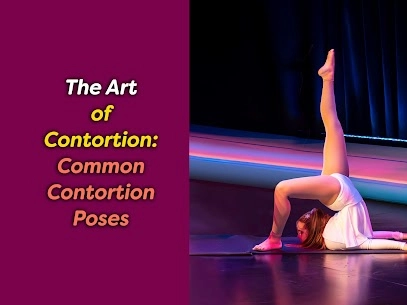
Contortion, with its mesmerizing blend of flexibility, strength, and artistic expression, captivates audiences worldwide. Behind the seemingly impossible poses lies a structured approach, where contortionists train rigorously to master a diverse array of positions. In this article, we delve into the most common contortion poses, shedding light on the five main categories that form the foundation of this captivating art.
The Five Categories of Contortion Poses
Nearly all contortion poses fall into one or more of the following categories:
Frontbending Poses: Utilizing the hips, legs, and back, these poses involve bending forward, showcasing the contortionist’s ability to fold their body with grace and control.
Backbending Poses: These poses require flexibility in the hips, back, and shoulders, often incorporating elements from the balancing category.
Twisting Poses: Requiring rotation of the spine, shoulders, and hips, twisting poses showcase the contortionist’s ability to create fluid, elegant shapes.
Splits Poses: Involving standing, sitting, or being suspended while extending muscles in the hips, quads, and hamstrings, splits poses exhibit flexibility and control.
Balancing Poses: These are typically poses from other categories that include an element of balance, adding an extra layer of complexity and artistry.
Dislocation Poses: Using the joints of the shoulder, elbow, and wrist, these poses create the visual impression of hyperextension, showcasing the contortionist’s control over joint movement.
1. Frontbending Poses:
Forward Fold: A classic frontbending pose where the contortionist bends forward from the hips, reaching towards the toes.
Seal Stretch: In this pose, the contortionist lies on their stomach, arching the back while lifting the upper body and legs simultaneously.
Bridge Pose: The contortionist arches backward, creating a bridge-like shape with the body, demonstrating flexibility in the back and shoulders.
Needle Scale: Combining back bending and balancing, this pose involves extending one leg backward while balancing on the other.
3. Twisting Poses:
Twisted Corkscrew: The contortionist twists their body, creating a spiral shape, showcasing rotational flexibility.
Pretzel Twist: This pose involves intricate twisting of the body, emphasizing flexibility and control in the spine and hips.
4. Splits Poses:
Chinese Split: A standing split where one leg is extended forward and the other backward, showcasing flexibility in the hips and legs.
Needle Split: Combining a split with back bending, the contortionist extends one leg backward while arching the upper body.
5. Balancing Poses:
Handstand Contortion: A challenging balancing pose where the contortionist holds a handstand, incorporating elements of other categories.
6. Dislocation Poses:
Elbow Stand: The contortionist supports themselves on their elbows, creating the illusion of hyperextension in the arms.
Achievement through Practice
While contortion poses may seem daunting to beginners, with regular practice and expert guidance, these positions become attainable for the average person. The art of contortion is a journey of self-discovery, blending strength, flexibility, and artistic expression. Aspiring contortionists can embark on this transformative path, gradually mastering poses that once seemed impossible, unveiling the boundless potential of the human body.
Contortion Training at Cirque Art Studio
The goal of Cirque Art Studio is to combine fun and fitness into unique circus performance art classes that improve your physical well-being and your mental focus. Our coaches are trained contortionists, gymnasts, acrobats, and experienced instructors.
Join us at our studio, located on Biscayne Boulevard, Route 1 North, in North Miami Beach, Florida near Keystone Islands. We are within a ten-mile drive from Aventura, Bal Harbour, Cooper City, Dania, Dania Beach, Davie, Fort Lauderdale, Hallandale, Hallandale Beach, Hialeah, Hollywood, City of Miami, Miami Beach, Miami Gardens, Miami Lakes, Miami Shores, Miami Springs, Miramar, North Bay Village, North Miami, Opa Locka, Pembroke Pines, Sunny Isles Beach, Surfside, and West Park.
Our classes, which consist of contortion and tumbling, flexibility, contortion, hand balancing, mixed aerial, including lyra and aerial silks, and circus skills like juggling, are available for kids, adults, beginners, intermediate, and for the more skilled. We offer in-studio group classes, individual instruction, personal group training, and virtual sessions.
If you’re intrigued by the idea of defying your body’s normal range of motion and exploring the world of contortion, Cirque Art Studio in Miami welcomes practitioners of all levels. Classes offered include:
Beginner Classes: Perfect for those taking their first steps into the world of contortion. You’ll learn foundational stretches and poses, gradually building flexibility and strength.
Intermediate Classes: Tailored for those who have mastered the basics, intermediate classes introduce more challenging contortion poses and sequences.
Advanced Classes: Designed for experienced contortionists, these classes delve into the art’s intricate and advanced techniques.
To book your class visit Cirque Art Studio’s website, explore our class offerings, and book a contortion session. Our studio provides a supportive environment where you can learn, grow, and push your boundaries under the guidance of experienced contortion professionals.